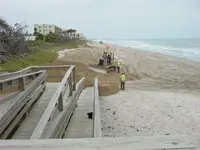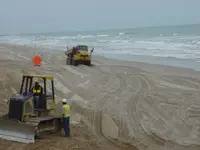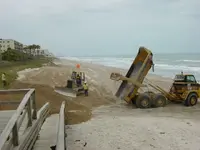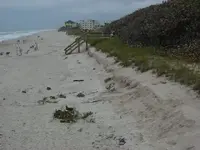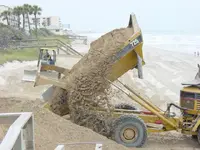Dune plants destroyed
FLORIDA TODAY • April 19, 2008
"Balsa" Bill Yerkes used to shore up the dunes behind his house by placing leftover Christmas trees on the sand and letting Mother Nature do the rest.
Last year, he stopped a neighbor from throwing out a dozen century plants so he could plant them on the dune behind his Satellite Beach surf shop. The county joined in as well, planting sea oats on the dune.
This week, Yerkes and his wife were stunned to see most of the vegetation on the dune destroyed by contractors hired by the county to replenish those very dunes.
"Vegetation is what prevents erosion," Yerkes said, pointing to a backhoe sitting atop the dune right by a sign warning people to keep off the dunes. "Without vegetation the rain comes and washes all the sand away. A good high tide can come up and take it out as well.
"Why don't they just dump the sand in the ocean now?" he added. "They're just wasting taxpayer money."
In February, the county embarked on a $3 million beach renourishment project that was seen as a short-term fix. More than $40 million has been spent since the 2004 hurricanes to replace beach sand. The project, slated for completion by the May 1 turtle nesting season, will have dumped 128,000 cubic yards of new dune sand by then.
A recording with the Brevard County Natural Resources Management Office says "Care will be taken in placement of sand in order to neither damage nor bury any vegetation that has established itself naturally or has been planted on the dunes."
'Unfortunate'
Mike McGarry, beach project manager with the county, called the incident an "unfortunate necessity," explaining that the contractor had no other way of getting the sand on the beach without destroying the existing vegetation.
"The contractor is replacing that vegetation at his own expense," McGarry said. "All that dune vegetation that was placed there was part of the restoration project. We try to impact it as little as possible."
McGarry agreed that the root system of the sea oats play a major part in keeping the dunes together.
"It plays a very large part," he said. "And the vegetation itself traps wind-blown sand. That's why it will be replaced."
This was not a problem during earlier parts of the restoration done in the South Beaches area, where the dunes were basically nonexistent. Florida Fish and Wildlife Commission biologist Allen Foley said it's common sense that the better vegetated a beach and dune are, the less erosion will occur.
Nola Yerkes, Bill's wife, said contractors assured her they would not disturb the existing vegetation on the dune. She could not understand the logic of dumping sand without properly reinforcing the dune.
"Last May, the rains came and washed it all away," said Nola Yerkes, blaming the lack of vegetation on the dune.
She was referring to the 2007 storms that were blamed for sweeping $10 million worth of sand from Brevard's beaches.
A grant from the Florida Department of Environmental Protection is funding between 40 and 50 percent of the project. County dollars are covering the rest.
A large-scale dredging project in South Beaches would cost up to $62.5 million, according to the county's coastal engineering consultant. So in December, commissioners directed the staff to look into setting up a beach and shore preservation district that would operate similar to the Sebastian Inlet Taxing District.
Off-color?
Some have complained about the new sand's coloring, which appears to be more orange than white. The contractor, CKA LLC of St. Cloud, has been using sand from five regional borrow pits in Brevard and Indian River counties.
McGarry said the sand is very good beach quality and that the color will change as it gets weathered and dries out a little.
"It's checked every day," McGarry said. "It's true that the material is slightly darker than what's on the beach but that's because it's wet. Once it dries, it lightens up."
McGarry said all the samples taken have met specifications of the quality control plan approved by the state.
He said roughly 100 samples have been checked so far and that everything has met specification.
"People like to use the word dirt but all the samples have met the state standard for beach quality," he said. "The county's standard is even stricter and the samples have met that standard as well."
Susan Valentine, a Floridana Beach resident who has taken an active role in pushing for beach restoration, said she was pleased with the project so far.
She said the wet sand will eventually change color.
"Twenty dump loads of wet sand are going to stay wet for a while," she said.
Foley with the Fish and Wildlife Commission said different color sand should not affect the ecology and the upcoming sea turtle nesting season as long as it is the same quality sand that already is on the beach.
"The two important questions are whether they can build the beach back up in the way it was naturally and are they good at determining if the sand is the same quality," he said.
"Mistakes in either regard may change things dramatically."
http://www.floridatoday.com/apps/pbcs.dll/article?AID=/20080419/NEWS01/804190341


